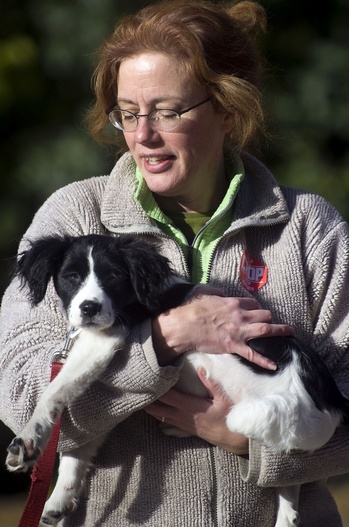AKC's STAR puppy program and owner behaviors

Hundreds of people participated on Oct 18, 2009 in the 35th annual Ann Arbor/Washtenaw County CROP (Communities Responding to Overcome Poverty) Hunger Walk to fight hunger locally and around the globe. Deb Pilutti of Ann Arbor had to carry her tired 12-week-old puppy named Willy the last few hundred feet of the 10k walk.
Mark Bialek | For AnnArbor.com
The program consists of a mandatory six weeks of training for pups and their owners. It is a fun program, and there are some obvious benefits to participation. Puppies that attend the program become well-socialized and learn skills that become the foundation for all other learning.
Our class at the Ann Arbor Dog Training Club is for seven weeks. It is a nice fit for us because we can allow for one absence per team (puppy and human) due to health issues or emergencies. Our class helps puppy owners to communicate with their puppies. We concentrate on modifying puppy behavior with treats and toys to teach all the elements in the S.T.A.R. Program, and we encourage handlers to praise and interact positively with their dogs. Harsh corrections are not permitted.
We incorporate all 20 test items into our class framework. The 20 items are separated into three categories: Owner Behaviors, Puppy Behaviors, and Pre-Canine Good Citizen Test Behaviors. (The S.T.A.R. Program must be taught by CGC Evaluators.) Since we are CGC Evaluators, we can describe to the class what is involved with some of the Canine Good Citizen test items and point puppy owners toward those behaviors. These puppies are not ready for the CGC test, but the exercises involved in the S.T.A.R. Program gets pups on their way. The first set of tests are for our puppy owners. They encourage the first-time puppy owner or those who have not had a puppy in a long time to be responsible dog owners.
Owner behaviors:
1. Owner shows proof that the puppy is in the care of a vet (vaccines, exams). We ask to see each puppy's health record at the beginning of the first class to make sure that the dog is in the care of a vet and up to date on shots. We also have owners read the Responsible Dog Owner’s Pledge.
2. Puppy appears healthy and active for the breed. We judge whether or not over the course of the seven classes the puppy is a normal, healthy puppy for its age.
3. Owner describes adequate daily play and exercise plan. We have our class write these as a “homework” assignment and they read them to the class. It gives other classmates great ideas for their puppies. We evaluate the homework to make sure that the puppy is getting a variety of play, exercise, training, and socialization. For instance, we often don’t think about it, but dogs that live in the country are socialized to many things, but not to city sights and sounds. So it’s important that they have some time in the city for training and socialization.
4. Owner and puppy attend at least six classes taught by an AKC approved CGC evaluator. As we mentioned in the beginning, we teach a seven-week class.
5. Owner brings bags to class for cleaning up after puppy. Although we have all the cleaning items available, getting in the habit of carrying clean-up bags is important. A responsible dog owner cleans up after her dog.
6. Owner has obtained some form of identification for puppy (collar tag, microchip, tattoo). In class we examine all tags and proof of microchip. This is an important aspect for owners in taking care of their dogs. We suggest that even if your dog is microchipped, he should also have a collar with the name of the company, telephone number, and microchip number. There are at least three different companies with microchip databases, and some machines read one company’s chip but not another’s. If a vet’s office finds your dog but the scan finds no chip, they won’t know how to notify you. A collar tag would inform the office that owner information can be acquired, just not with the electronic reader they have. There are many beautiful dog collars out in pet shops, but the most important thing a puppy has is her/his identification. You could also use the Washtenaw County Dog License tag (responsible dog owners license their dogs).
In our classes, owners regularly brag about and chat about their puppies to others in the class, and many arrange play dates with other dogs in the class. It’s great to see people being proud of and bonding with their puppies. Developing this magical bond that will last a lifetime is the goal of our class.
Next week we’ll talk about the five Puppy Behaviors of the S.T.A.R. Puppy Program.


Comments
Theresa Taylor
Fri, Feb 12, 2010 : 9:46 a.m.
Good to know! We just brought an 11 week old German Shepherd into our home. She's been fabulous and potty training was a BREEZE!